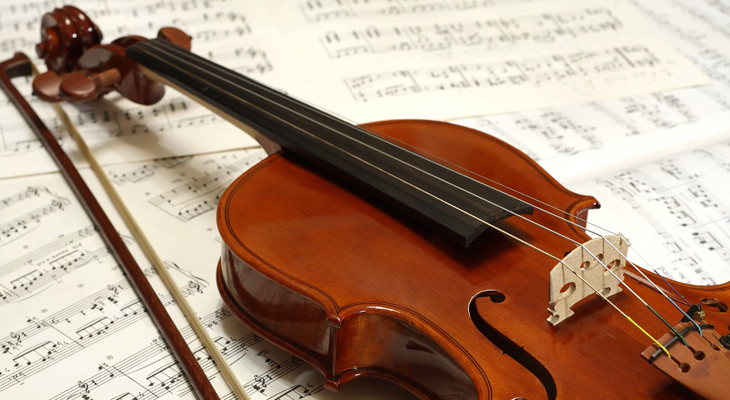
A Stradivarius is a violin or other string instrument, such as a viola or cello, produced during the late 17th and early 18th centuries by members of the Italian Stradivari family. They are widely regarded to be the best-sounding string instruments in the world. In this article, we will not only explain why this violin is so special, we will demonstrate and even test you! Scroll to the bottom to see if you can pick a Stradavarius violin from others!
The master luthier, Antonio Stradivari, was born in Cremona, Italy in 1644. Historians estimate that he produced some 1,116 instruments during his long lifetime (he lived until he was 93 years old). Some 960 of his creations were violins. In the present day, about half of the instruments he created survive, with some 450-510 of these being violins.
So how much are they worth, and why?
An original Stradivari string instrument, with particular reference to violins, can fetch hundreds of thousands, if not millions of dollars at auction, and this is because of the pervasive belief that they are the finest instruments of their kind ever created.
Many cite the beautiful sound and the construction of a Stradivarius violin as the two key factors that make it worth paying millions of dollars to acquire, however many scientific experiments comparing a Stradivarius violin to its contemporaries in both period and quality of construction have not found any noteworthy difference in sound quality.

If that's the case, then why do people pay tens of millions for them?
Many of the world’s greatest violinists, such as Joshua Bell (pictured), swear by their Stradivarius violins - perhaps quite understandably considering the millions of dollars they spent acquiring one or more of the instruments.
Back in 2003, scientists at Columbia University in the USA cited a higher-than-usual wood density with superior acoustical qualities for the distinctive sound produced by Stradivarius instruments. This increase in wood density was due to reduced solar activity in the 17th Century, which has not been repeated in the time since. Trees that are less exposed to sunlight grow at a slower rate than those that get plenty, thus their density is higher.
The best-sounding Stradivarius violins of all are said to be the ones that have been set up properly, with modifications or additions such as the thickening of the wooden plate, the movement of the sound post and bass bar.
Listen to Anne Akiko Myers play the ex-Napoleon Stradivarius:
The shape of the instrument is said to make a big difference to how it sounds. The many varying Stradivarius shapes are reflective of the master luthier’s pursuit of perfection. Stradivari was constantly trying to produce better and better wares, and took the feedback he was given from musicians who played his violins very seriously.
Above all else, experts agree that the key differentiating factor that Stradivarius violins have over others is their sheer clarity of tone. However, they add that every single instrument produced by Stradivari has a very strong personality of its own, therefore even the best violinist has to take the character of the instrument into account to reap the rewards it can offer.

The most expensive Stradivarius violin sold to date is the Lady Blunt (pictured above). It fetched $15.9 million at auction back in 2011. It was created during Stradivari’s so-called “Golden” period – between 1700 and the early 1720s – when the master is widely believed to have been producing his very best work. It is one of the two best-preserved Stradivarius violins in the entire world.
Can you pick a Stradivarius violin from its sound alone? Find out with this next video:
Images by Deposit Photos and Wikipedia.
 4:25
4:25
How to Impress a Woman According to This String Quartet
Watch a fascinating combined-skills performance by a string quartet.
 3:40
3:40
Andre Rieu Performs an Irish Tune with Florian Silbereisen
Andre Rieu plays alongside Florian Silbereisen, performing a wonderfully-inspired Irish tune.

You’ll Never Guess the Price Tags on These Luxury Plants!
Believe it or not, each of these houseplants costs thousands of dollars. Find out why.
 3:42
3:42
This Violin Rendition of 'Unchained Melody' Is STUNNING!
Listen to one of the best renditions of the world-famous song "Unchained Melody" performed by the talented child violinist Karolina Protsenko.
 2:22
2:22
This Beautiful Archlute Performance Will Make Your Day
Watch a musician perform a mesmerizing rendition of J.S. Bach’s 'Prelude in C Major' on the archlute.
 2:55
2:55
Groove With This Lively Violin Street Performance by Kids
Check out this amazing violin street performance by a young artist that is bound to make you want to groove.

Norovirus Cases Rise This Season: What You Need to Know
Cases of norovirus, commonly called "winter vomiting disease," are spreading across the United States earlier than usual this season, with levels rising since mid-October according to wastewater surveillance data.

Research Shows: Just 2 Spoons of This to Lose Weight
Cider Apple vinegar is making headlines again following a study that found two tablespoons of it per day may greatly help with weight loss and improving blood sugar. Even more than expensive medications and treatments with many side effects.

Only Michelangelo Can Turn Marble into a Masterpiece
There's no task quite as painstaking as sculpting an image that can come to life. These are some statues created by the genius Michelangelo
 4:47
4:47
Amazing Sleight of Hand!
Yann Frisch is an amazing sleight of hand magician, and if you don't believe it, just watch this amazing trick, using nothing but tomatoes, a cup and his hands!

Immaculately Made: Paper Cutout Art by Pippa Dyrlaga
10 works of paper art and colorful paper cutouts.

The Revolutions That Sparked These 5 Famous Paintings
These 5 famous works of art were sparked by different revolutions and tell absolutely fascinating histories.

Hiroshige Is One Classic Japanese Artist You Must Know!
Immerse yourself into 19th-century Japanese culture through the magnificent prints of Hiroshige, the last great master of the famous ukiyo-e art tradition.

Have You Ever Seen Banana Art? 15 Lovely Illustrations
Art can be created on virtually anything. For Anna Chojnicka, the unconventional canvas of choice is... a banana! Check out her lovely illustrations.

Each of These Cakes Belongs In a Museum
Each and every one of the cakes made in Moscow based bakery Tortik Annushka is a work of art!
 3:08
3:08
A Heavenly Number Steered by Our Favorite André Rieu!
This is surely one of Andre Rieu's finest musical moments...

Michelangelo's David Looks Even More Astonishing Up Close
This is the world's most famous statue, but you never realised how amazingly detailed it is - until now!

Take a Closer Look at These Animals - You'll Be Impressed!
This art is beyond incredible. Take a look at how an unusual canvas can be transformed

MUSIC BOX: These Songs Influenced Entire Generations...
Some songs just tend to stick in the collective consciousness and influence a generation, changing the world forever. Here are 10 of the most influential.

10 Oscar-Winning Foreign Movies You Can’t Afford to Miss!
This list has 10 must-see foreign films that were winners of the Academy Award for Best International Feature Film in the past ten years
 5:00
5:00
This Performance Won't Fail to Leave You Smiling!
What a stunning and exciting instrumental performance!

Stone Giants: The Most Amazing Outdoor Sculptures Around
Pictures and videos of colossal works of public art

MUSIC BOX: 20 legendary Bruce Springsteen Hits
Here 20 of Springsteen's greatest and most popular rock 'n' roll anthems. Roll back the years and sing along with The Boss himself.

12 Jewelry and Decor Pieces With Lush Landscapes Within
We’re about to show you some extraordinary artisan creations - little dainty things that hold an entire vibrant fantasy world inside.

6 Fantastic Poems Everyone Should Read At Least Once!
These are some of the most famous poems that have ever been written and everyone should read them at least once!
 5:18
5:18
Watch a Beautiful Visualization of Liszt's La Campanella
Listen to a masterful rendition of La Campanella, along with a brilliant visualization of each and every note this is being played.

11 Picasso Paintings That Shocked the Art Establishment
If there is one artist of the 20th century that everyone knows, it's Picasso. Here are the 11 works of his that shocked the world and cemented his fame forever.

23 Times Street Art and Nature Coexisted Beautifully
Urban art doesn't have to be in opposition to nature, and can actually complement it. Check these examples out!
 5:15
5:15
Andre Rieu Stirs Our Emotions With his Tribute to Sinatra!
Join Andre Rieu and his orchestra in their tribute to the unforgettable Frank Sinatra, as they perform "My Way".
 6:21
6:21
This Dance Troupe Literally Lit Up the Place!
The group The Blackouts recently reached the semi-finals of the show, soared above the stage, and left all the viewers in awe.

The Detail in This Artist’s Sculptures Left Me Speechless
You can't ignore the magnificent works of Yuanxing Liang, the impressive Chinese artist who manages to convey emotions with his clay sculptures ...

These Stunning Tree Carvings Are a Sight to Behold
Wood carvers and sculptors are truly gifted individuals, and this is evidenced by their amazing work at these 9 places. View their beauty for yourself.

The Silent Power of Monochrome Sculptures (16 Pics)
These beautiful monochrome sculptures by Hans Op De Beeck capture moments of quiet contemplation.
 4:58
4:58
Jonglissimo Reinvents Juggling in a Mind-Blowing Way
You are invited to watch this wonderful performance yourselves and share it with all your friends who will enjoy seeing such a display of juggling, special tricks, and talent.

History’s 7 Most Influential Watercolor Artists
Here, we look back at some of the most famous watercolor artists throughout history whose works continue to be influential.
 4:59
4:59
This Salsa Performance is One Big Surprise!
Watch a hilarious yet beautiful dance performance by a very unlikely duo.
 5:27
5:27
Andre Riéu Takes Us on An African Musical Ride
Another incredible musical performance by Andre Riéu, inspired by Africa.

How Could Carvings so Intricate & Tiny Have Been Handmade?
These boxwood carvings are among the most mysterious little wonders in art history. Now, finally, science appears to have explained just how they were made.
 5:07
5:07
This Orchestra is Like Nothing You've Seen Before...
Presenting you The Ukulele Orchestra of Great Britain, as they play one timeless and unexpected soundtrack. Give them a listen!

These Tables Clearly Prove There’s No Limit To Creativity!
The following pictures show that even the simplest piece of household furniture, the table, can be the most impactful!
 4:34
4:34
Smile as These 2 Prove You're Never Too Old to Dance!
If you think you're too old to dance, then you'd better think again!
 4:33
4:33
Watch Evgeny Kissin Give New Life to "La Campanella"
Watch pianist Evgeny Kissin play "La Campanella" at The Royal Albert Hall, London, in August 1997.
 4:46
4:46
This Performer Will Shock and Inspire You
Once you finish watching this performance, you too will be filled with admiration for this extraordinary man who has no limbs but a lot of heart.

Bette Midler’s Beautiful Song in a Stunning Presentation...
This song talks about the power of love in healing, empowering and reviving if you only believe that it still exists.

12 Unique Artists and Their Gorgeous Creations
we'd like to show you 12 of our favorite creative artists.

This Japanese Tradition Takes Art to a New Level!
See how the Japanese continue the tradition of the rice harvest season by creating gigantic straw sculptures.
 5:07
5:07
Incredible Trapeze Performance by Duo Artemiev
these dual performers, the 'Duo Artemiev', offer a great trapeze number which is both beautiful and impressive, not to mention their original invention. It is a graceful, gentle and fascinating performance!
To enable your Ad-Free Subscription, please fill the fields below
Your subscription was successful, now you can enjoy an ad-free experience!! Note: To make sure you get no ads, please make sure to log in to your account. If you are logged in already, then refresh the page. The subscription can be cancelled at any time.


